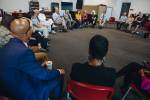The Big Picture
It's pretty much like attending any other church service. Worshippers can meet one another in the lobby. They can sing along to an upbeat worship band. They can hear a powerful sermon. They can drop a few dollars into the collection plate and submit prayer requests, and first-timers can get information about the next step in their spiritual walk.
So, with all of this, does it really matter that worshippers at The Church at South Las Vegas' Internet campus also can attend church while still wearing their jammies?
The church's online campus, which offers worshippers in Southern Nevada and all over the world live, interactive access to the congregation's services, is just one of the ways valley faith communities are employing technology toward spiritual ends. They also are making the most of Facebook, Twitter and other social networking sites just like those in other walks of life.
The Church at South Las Vegas' online campus was unveiled last month, notes Shanen Chavez, a graphic designer at the church who, with other staff members, dons headphones during services to communicate with far-flung worshippers in real time.
Already, she says, the online services have received logons from between 400 and 500 unique Internet service providers and worshippers from throughout the United States and 14 other countries.
Among them, for example, is a girl from Hungary, Chavez says. "It's like 3 a.m. her time, and she stays up to watch the service."
Live Internet streaming of worship services has been available for several years, but at The Church at South Las Vegas, the concept is taken one step further. Online worshippers who log on (www.thechurchlvlive.com) can comment live, ask church staff questions, follow a link to an album that contains the song the worship band is performing, and click on additional links for "live prayer," "live help" and, for new Christians, "Next Steps."
During one recent service, the corps of online worshippers -- logged on from as far away as Orlando, Fla., Seattle and New Jersey -- even included a woman who had to log off early because, she explained, she was going into labor, prompting promises of prayer from others online.
For Chavez, it's the interactive component that makes the online campus effective. "We respond to people with chat and have people ready to pray" with them, she says. "If they did 'live prayer' or 'live help,' they'd get an immediate response from one of the partners."
Online congregants include people who are searching for a church to join, people who are reluctant to commit to a church in person and those who, for reasons of work or family, aren't able to attend the service in person, Chavez says. Some even are former members who have moved away but wish to maintain ties with the church.
The interactivity also enables church staffers to learn about online worshippers' lives and needs.
"We don't hear from everybody who logs on, but they'll post in the chat room, 'My daughter is sick. Pray for me,' " Chavez says.
At Temple Beth Sholom, Rabbi Felipe Goodman has been blogging for about a year. He also has been on Facebook for about a year, but concedes that, for most of that time, "I never did anything with it. It was just a lot of friends, saying 'Happy Birthday.' "
Then, about three weeks ago, he began using his Facebook page to post links to newspaper columns that he found interesting. "And a funny thing happened," Goodman says. "I would link to an article in Facebook and, within minutes, people had read the op-ed and were recording their comments of the article I'd post, and it started a whole discussion, which was unbelievable."
Now, Goodman uses Facebook to communicate with congregation members, colleagues and others, and also maintains a Twitter account to offer additional links. And, he continues to blog (http://www.torahfromsincity.com/blog/).
"There's a lot of interest in the blog," Goodman adds. "I get more comment from my blogged articles, sometimes, than my sermon from the bimah. Whether they like them or not, I am reaching people that, frequently, were not in the synagogue. I'm able to reach people I was not able to reach, which is a tremendous thing."
Pastor Benny Perez of The Church at South Las Vegas opened a Facebook account about a year ago. From there, it was just a small step to Twitter, where church members and other followers now read as much about Perez's family and personal life as they can his more spiritually oriented messages.
"I don't want to be anything else than just a real guy who happens to be a pastor and loves Jesus," Perez explains. "I'm raising a 9-year-old and a 5-year-old and a 20-year-old like anybody else. People like to hear that even a pastor has challenges."
Meanwhile, Central Christian Church offers its own Internet campus (www.CentralOnlineCampus.com) with services tailored to online viewers from around the world. And, for worshippers in Southern Nevada who don't live near the church's main campus in Henderson, high-definition technology has added a new dimension to classic video evangelism.
At Central Christian's two regional campuses, in the northwest and southwest parts of the valley, worshippers gather in auditoriums to pray, listen to on-site worship bands and participate in the basics of any live worship service. But, when it's time for the Rev. Jud Wilhite's message, screens lower and worshippers watch a life-sized, high-definition image of the pastor.
Kurt Ervin, Central Christian's executive pastor of church expansion, explains that, during each Saturday evening's service at the main campus, Wilhite's message is captured on high-definition video. The video then is copied and, the next day, taken to the regional campuses.
"When the time comes to play the message, we play back the message that Jud preached Saturday night and play it back Sunday morning," Ervin says.
Because the video is high-def, and because it plays on a screen 17 feet tall and 21 feet wide, it looks, Ervin notes, "like he's standing onstage."
The effect is so similar to watching a live speaker that, Ervin adds, "we've had, literally, people come up after the sermon and want to shake Jud's hand."
"We've done some studies and we've learned that, within 21/2 minutes of the video rolling, people forget they are watching a video," Ervin says. "They're engaged, and they watch the video as if it's a real-life person. If (in the video Wilhite) says, 'How many of you have been to the ocean?' they raise their hands and respond and laugh at jokes and clap when something is good."
Ervin notes, however, that each campus does have its own pastor, its own worship band and choir, its own children's and youth pastors, its own staff and its own roster of small groups for members to participate in. Except for Wilhite's virtual messages each week, each campus is its own working church campus.
"What we've learned in this day and age is people generally won't drive more than 20 minutes to go to church," Ervin explains. So, the video system enables worshippers from other parts of the valley to have the same worship experience they'd have if they were attending the main Henderson campus.
Purists may consider all this high-tech hoopla strange, or even inimical to a true worship experience. But, Ervin notes, "there are more than 300 million people in Facebook. Now, people work online, they bank online, they go to school online, they shop online. Why not go to church online?"
Perez suspects that a faith group's willingness to embrace technology in the service of ministry depends largely on how comfortable its leaders are with technology.
The Church at South Las Vegas identifies itself as "nondenominational charismatic," he says. "I know a lot of my friends I associate with around the country, every one of them tweets. Every one of them has Facebook. I think that's just part of the church culture."
In contrast, Perez continues, some clergy "are still very traditional in worship experience, so that carries over where they're not going to adopt, probably, a lot of the technology that we are using right now."
Ervin would agree that the sense of community created online differs from its real-life analog. "You don't get the face to face," he says. "But obviously there is a connection with people through social means, Facebook, Twitter, MySpace.
"It's not the same. I would never say that. But there is some benefit to it. What's cool about our online campus is, on a regular basis, we have about 50 states represented and over 38 different countries."
And, Ervin notes, attracting people via online services, or connecting them to a faith community via other high-tech means, may be a great first step in, eventually, establishing a connection with them in person.
Contact reporter John Przybys at jprzybys@reviewjournal.com or 702-383-0280.




























